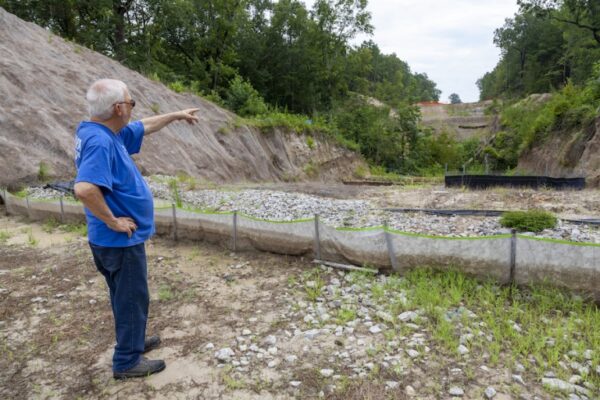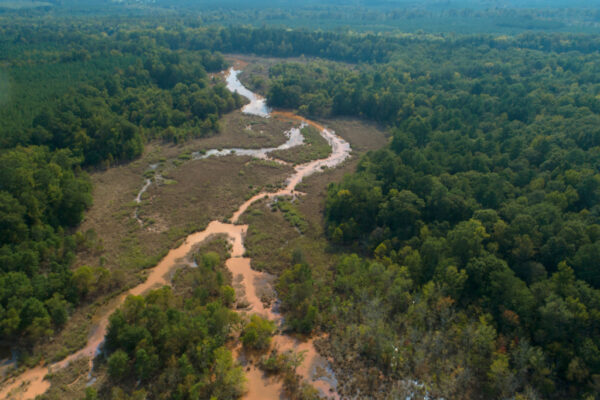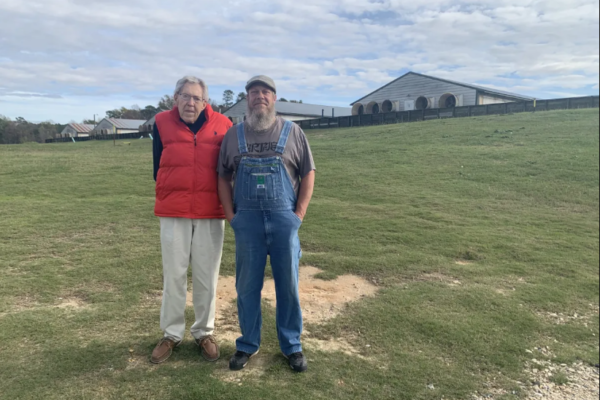By: Lisa Sorg, NC Policy Watch
July 30, 2020
Environmental destruction, property entanglements will take years to address
In November 2018, freelance photographer and videographer Charlie Sarratt shot drone footage of the ACP construction in Cumberland County. You can view it here, courtesy of Donovan McLaurin.
Behind a black wooden farm gate, near Wade in Cumberland County, used to lie a meadow. Serene, tree-lined, it was a spot of utopia where Donovan McLaurin had planned to build a small house for himself.
Instead, the land has been defaced. Hills of dirt two stories tall are splayed to reveal a rugged gash in the earth. This is part of 11 acres that Atlantic Coast Pipeline, LLC, seized from McLaurin to build its ill-fated natural gas project.
McLaurin, who is 73, was among the holdouts. He never agreed to allow the utilities — Duke Energy and Dominion Energy — to cross his property. He wouldn’t accept their offer of $36,000 that was supposed to compensate him for land that has been in his family for five generations. When they doubled the price, he turned them down again.
“It was legalized extortion,” McLaurin said.
He refused to comply with a summons from a federal court, so with approval from a judge and vested with power under the federal Natural Gas Act, Duke and Dominion, took part of his property. They placed an unknown amount of money, to McLaurin, in escrow to some day compensate him.
Then they began to slash and carve and dig.
But on July 5, the utilities unexpectedly canceled the project after six years and millions of dollars. They cited ongoing legal and permitting battles that had increased the project cost from $5 billion to $8 billion.
Now hundreds of landowners and thousands of parcels along the pipeline’s 600-mile route, including 160 miles of eastern North Carolina, are left in limbo.
The landowners can keep their money. But the utilities still have legal rights to the easements, which clouds the title to the property should the owners sell or bequeath it.
The environmental carnage, though is done: Wholesale clear-cutting of hardwood forests, burrowing through prime farmland, installing pipe under the Tar River. It’s unclear how Duke and Dominion will repair the damage, or if it’s even possible, except by the passage of time.
McLaurin had agreed to sell two home lots in the former meadow, deals that had to be scrapped when the pipeline routed through. About 200 feet away had also hoped to build his house.
“It would have been a nice place,” he said. “But the pipeline was going to go between the commode and the shower.”

Five days after Duke and Dominion announced they were scrapping the Atlantic Coast Pipeline, lawyers convened in federal court in Raleigh, an hour or more from communities along the route.
The utilities had negotiated with more than 2,000 property owners and negotiated deals worth millions of dollars for 1,000 parcels of land in North Carolina. Of those owners, Duke and Dominion used eminent domain to take property, in the form of easements, of 80 people who didn’t want to sell.
Sometimes the utilities sued and reached a voluntary settlement. In other instances, like McLaurin’s, the utilities got a court order to seize the land. And there were still 20 or so landowners whose cases had not been decided in court.
The fate of the easements and their legal status is unclear. Because the utilities own the easements, it complicates the legal titles for the entire properties.
US District Judge Terence Boyle, whose courtroom temperament can be surly on a good day, seemed peeved by the utilities: “Here they [the ACP] are aggressively taking the bit in their teeth and running through several states grabbing land and throwing money,” he said, according to the court transcript, “and on a Sunday afternoon they decide, well maybe we don’t need this anymore and let’s just fold up our tent.”
Boyle asked the ACP attorney how they plan to deal with the easements. “You’ve got tens or dozens or hundreds of easements … checkerboarded throughout this area. … You’ve spent the money. The landowner has the money. The landowner has the property with the burden of an easement impressed on the land. It doesn’t go away. It will be there in perpetuity.”
Attorney Henry Kitchen of the powerful firm McGuireWoods, is representing the ACP. “I don’t know what my client will decide to do with those easements,” he told Boyle, according to court transcripts. “I don’t think my client knows.”
It appears the easements cannot be transferred for a different use, such as a road or oil pipeline. Kitchen told the judge that all of the easement agreements he has seen stipulate that the land can be used only for “one natural gas pipeline.”
The utilities still owe some landowners, like McLaurin, money. For example, the court had granted ACP, LLC, “early entry” to the property to cut trees when it would less likely harm migratory birds, as required by FERC. But there was no agreement on the final price.
In these cases, ACP attorneys will negotiate with the landowners’ attorneys, Kitchen said. But in situations, where “there is no lawyer on the other side because the defendants have never appeared,” then a judge will have to determine a price.
For McLaurin, no dollar amount can compensate for the loss. “They screwed up my house,” McLaurin said. “They killed my plans.”
On his immaculate 300-acre farm, McLaurin raises his two horses and hunts wild turkey and deer. Since his land is close to the Cape Fear River, it is stippled with swamps and veined with streams, habitat for countless animals, birds, reptiles and plants.
“In the back of my place, they cut trees— big poplars, water oaks, pines. They’re all gone,” McLaurin said, as we rode an ATV along a ridgeline through the woods.
Duke Energy has said it will seek approval from the Federal Energy Regulatory Commission and other agencies “to complete restoration” for areas that have been disturbed. Pipe that has been installed, such as under the Tar River in Nash County, will be left in place because “there would be more environmental disturbance if we were to remove the pipe.”
But how these plans will come to pass — and how quickly they’ll be accomplished — is unclear. FERC spokesman Craig Cano told Policy Watch that the commission “considers issues of site restoration as they arise.”

North Carolina Department of Environmental Quality spokeswoman Laura Leonard said the agency “expects all disturbed areas to be returned to original contours and permanently stabilized.” The Division of Energy, Mineral and Land Resources will also conduct on-site inspections, Leonard said.
Cathy Cralle-Jones represented several landowners in Nash, Halifax and Wilson counties, including those that had worked with the Blue Ridge Environmental Defense League. She successfully petitioned Judge Boyle to hear landowners’ claims and concerns even after ACP, LLC, dismissed her five cases.
Marvin Winstead of Nash County is among those whose case was dismissed. For more than two years, he and Cralle-Jones had legally thwarted the utilities’ attempts to seize part of his land. “I still can’t believe it’s over,” Winstead said recently, as he walked through his soybean field where the pipeline would have been.
Winstead recently received a letter from the ACP, LLC, telling him it is “committed to keeping affected landowners informed.” The utilities said they will work with local, state and federal regulators “to determine how best to minimize the environmental impact associated with any restoration necessary for the rights of way.”
Even though construction had not started in earnest, the impacts are widespread in North Carolina. In Northampton County, Belinda Joyner, who lives in Garysburg, recently led a two-car tour of the destruction. In many spots, it’s clear how the pipeline route would have grazed the modest homes along the way, including farmworker housing. Joyner calls these neighborhoods “sacrifice zones.”
Thousands of feet of pipe rest alongside fields of cotton. The pipe coating is made of epoxies that contain several chemicals, including BPA, also known as Bisphenol-A. Exposure to BPA has been linked to reproductive and developmental effects and an increased risk of diabetes.
Ingredients in the epoxy can be toxic to internal organs and irritate the skin. Exposure to the epoxy itself, manufactured by 3M, can cause cancer.
DEQ said the ACP has “verbally indictated that no pipe or construction materials would be left onsite.”

Mounds of dirt on farmland extend into the horizon, as if a giant mole had burrowed beneath the fields. Thousands of railroad ties were installed in the ground for equipment to pass over. Some of them are still stacked in large piles. The railroad ties can go to a Construction and Demolition Landfill, or reused elsewhere, Leonard said.
DEQ doesn’t require a specific plan to dispose of construction materials, unless the utilities “plan to bury the materials outside of the approved disturbed area,” Leonard said. If the utilities decide to bury the materials onsite, they would need to coordinate with DEQ.
The amount of restoration required on McLaurin’s land will take years. Trees will regrow — in some places along the route, saplings have taken root — but it will decades for them to mature and rebuild the habitat. The underground network of fungi, and the neighborhoods of insects, grubs and earthworms will gradually return.
This process will take longer than McLaurin’s lifespan. His children and grandchildren, though, could witness nature heal itself.
“It’s done. What can I do?” McLaurin said, in a tone of resignation. “I’ve got to let it go. It’s not mine forever.”





